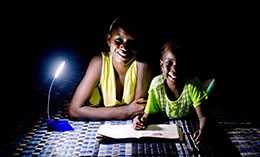IFC-World Bank Study Establishes Significant Climate Benefit of Solar Lighting Products

The study confirms that modern solar lighting products designed for low income families without access to grid electricity are far more energy efficient than widely used kerosene lamps.
“Fuel-based lamps require a small amount of energy to manufacture, but then consume a large amount of energy through fuel burntdaily. A solar-powered electric light, by contrast, requires a larger energy investment to manufacture, but consumes no further fuel because it generates its power from the sun,” says Dr. Arne Jacobson, technical lead for Lighting Global, a sister program to the IFC-World Bank Lighting Africa program.Dr. Jacobson is also a Director of the Schatz Energy Research Center at Humboldt State University.
The study found that quality-verified solar lanterns, which have been championed and promoted by the Lighting Africa program since its inception in 2007, typically reduce a family’s consumption of kerosene for lighting by at least 50 percent. Such lamps can completely replace kerosene-fueled lamps from a household.
“Replacing kerosene lights with solar powered products thus represents a local solution that has significant positive global implications,” says Dr Jacobson. Today 1.4 billion people across the globe rely on fuel-based lighting such as kerosene that emit carbon dioxide and black carbon (soot).
The study, titled Energy and Carbon Benefits of Pico Powered Lighting, reviewed small modern solar powered lighting products designed for households in off-grid areas or locations with unreliable grid electricity. They include flash lights, portable lanterns, task and ambient lights, as well as solar home lighting kits that can light more than one room and power appliances such as radios, fans and TV sets.
The study is part of a series of Technical and Eco Design Briefing Notes published by the Lighting Global program to build knowledge on various aspects of modern off-grid lighting products designed and developed for the consumers not connected to grid electricity.
The study used an energy return on investment (EROI) analysis to estimate savings. The study found that an EROI of 1.0 represents a product that saves exactly as much energy as the energy it consumes. The EROI ratios for pico-solar were found to be quite high—about 15‐45 (depending on the kerosene replacement scenario) for products with a 2-year lifespan. While upfront costs are higher, these products pay for themselves many times over from an energy perspective.
Quality verified solar products often have a lifespan of two years, although some last longer. Because of their energy efficiency and use of no fuel, they are able to very quickly offset the energy used in their manufacture and transportation when compared with kerosene lamps. The simple energy payback for such solar lighting products was found to be between one to three months for the products evaluated by the study.

